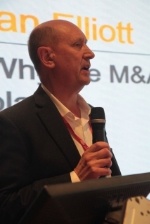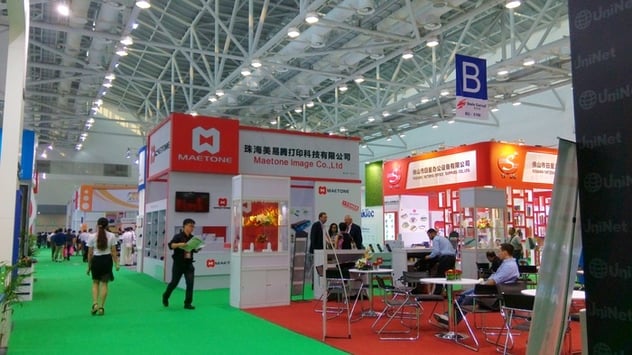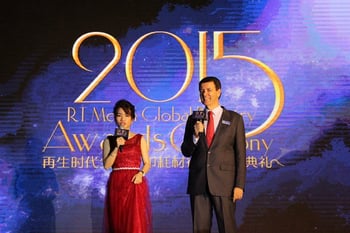I have three observations to make after attending the RemaxWorld Expo and Summit in Zhuhai, China.
First, Zhuhai has continued to grow and prosper since my first visit nearly twenty years ago, and even my most recent of four years ago.
"> 
Second, the show, located in the world-class Zhuhai Convention Center, was huge—occupying a space equivalent to the area of five football fields accommodating 13,938 attendees from some 80+ countries and 463 exhibitors.
But, third, and most notable, was the remarkable atmosphere of innovation, enthusiasm and optimism—much like the bustle and energy of the US-based World Expo, 15-20 years ago.
 The World-Class Zhuhai Convention Center, PRC
The World-Class Zhuhai Convention Center, PRC
Given that the largest markets for office consumables are Western Europe and the United States, I was surprised the prevailing Western pessimism did not overwhelm the Zhuhai event—after all, the Chinese manufacturers, heavily concentrated in their "Imaging Supplies Capital of the World", are all seeking to distribute their products into these large western markets.
If there's a genuine cause for pessimism in the Western markets, why is there such a sense of optimism within the area that's counting on those markets to fill their factories?
Let's consider some of the challenges discussed in the Summit, and that were observed walking the show and talking to industry leaders.
-
Between the OEM and Aftermarket manufacturers there's clearly an excess manufacturing capacity exacerbated by the slow decline in demand for cartridges. In addition, there’s downward pressure on price as more and more manufacturers enter the field, further increasing capacity and potentially accelerating the pricing spiral.
-
The barriers for Chinese manufacturers to penetrate "big-box" distribution channels for volume in Western markets are formidable. I would strongly argue it's not going to happen. As a result, much of the Chinese product is, and will continue to be, sold at very low prices via online marketplaces such as Amazon and eBay. Despite their appearance in these channels over recent years, overall aftermarket share has not moved much. Therefore, the share these products have obtained must have been at the expense of existing aftermarket players rather than the OEMs.
-
The definitions now set in the German legal system for "repair" versus "reconstruction", as explained by patent attorney Dr. Katja Dauster, establish an ominous undercurrent for the future of high quality remanufactured products in Germany. Furthermore, if, as seems likely, other European countries follow the German legal methodology, it's possible we may be nearing an end to the era of remanufactured cartridges in Europe.
-
Hewlett Packard's drive toward replacing laser with ink technology is likely to have a significant long-term impact on the future for laser cartridges. Clearly HP is seeking to establish full control over its technology platform - something it enjoys with ink, but not with toner. No doubt HP considers it desirable to eliminate Canon from its value chain and to keep the currently shared portion of margin for itself.
-
There was tremendous buzz surrounding 3D printing at the Expo. However, in the traditional office products category, it's been common practice for hardware to be underpriced compared to its full manufacturing cost, and for high priced consumables to make up for losses. There’s a profound difference in the current 3D model in that, while the hardware is priced very low, so are the consumables. Furthermore, with HP entering the market in 2016 I believe commercialization of 3D printing will enter a new phase. The new machines will be priced much higher according to their scale, complexity and technology and there will be a need for equipment financing. It's difficult to see the low-end printers, currently dominated by the Asian manufacturers, surviving beyond the hobbyist market. If these companies are to graduate to the higher-end machines in order to compete with the likes of HP, they will need access to traditional distribution channels and the relationships necessary for equipment financing.
 The Zhuhai Convention Center - Show Floor
The Zhuhai Convention Center - Show Floor
On the flip side to these headwinds it was difficult not to be impressed with the aftermarket technology on display. The new product hurdles that can be overcome today compared to 10, 15 and 20 years ago, and in such a short space of time after OEM launch, are quite impressive. Whether it be patented features on cartridge designs, new toner technologies, OPC drum designs, or increased technology on the "smart" chips controlling the interface with the hardware, the aftermarket appears well equipped to deal with these challenges. Just as important, the leading Chinese manufacturers have established a deep understanding of patents and developed their own IP portfolios necessary to defend their products.
However, despite these positives on technology and intellectual property, are they sufficient to overcome the headwinds and justify the clearly evident sense of optimism? Let's think about the following possibilities;
-
Perhaps remanufacturing of ink and laser is nearing its terminal phase and compatibles will take over. Let's not forget, in most cases, compatible cartridges cost less to manufacture than equivalent remanufactured cartridges and therefore have an inherent advantage. Should this shift occur, it will play into the hands of the two Chinese powerhouses, Ninestar and Print-Rite, who have invested heavily into compatible laser technology over the last 10-15 years.
-
The Ninestar family, in terms of its Apex/SCC combination now dominates chip technology for ink and laser cartridges. Given chips have become one of the most important components on the cartridges it gives Ninestar a clear advantage.
-
In Western markets, where DepotMax/Staples have a strong presence, the distribution channel may collapse under pricing pressure from Asian products selling through online marketplaces. Don’t forget, weak balance sheets and heavy expenditures to finance store closures and achieve synergies mean they are ill-equipped to deal with price pressure. This situation could lead to a major shift in market share toward the Asian manufacturers.
Time will tell whether or not these possibilities may account for the underlying enthusiasm and optimism evident at the Expo. It’s really difficult to predict what may be, but one thing for sure, changes are coming and we need to be prepared for all possibilities.

RemaxWorld Expo, in a class of its own, is a must for those seeking an excellent source for industry intelligence.
This article is also published in the November 2015 print edition of Recycling Times in English, Spanish and Russian and distributed around the globe in hard copy as well as available online at www.iRecyclingTimes.com
David Gibbons & Beckii Li announcing the 2015 Industry Awards











